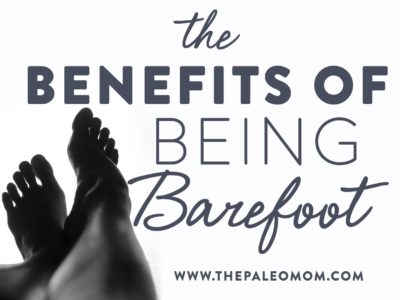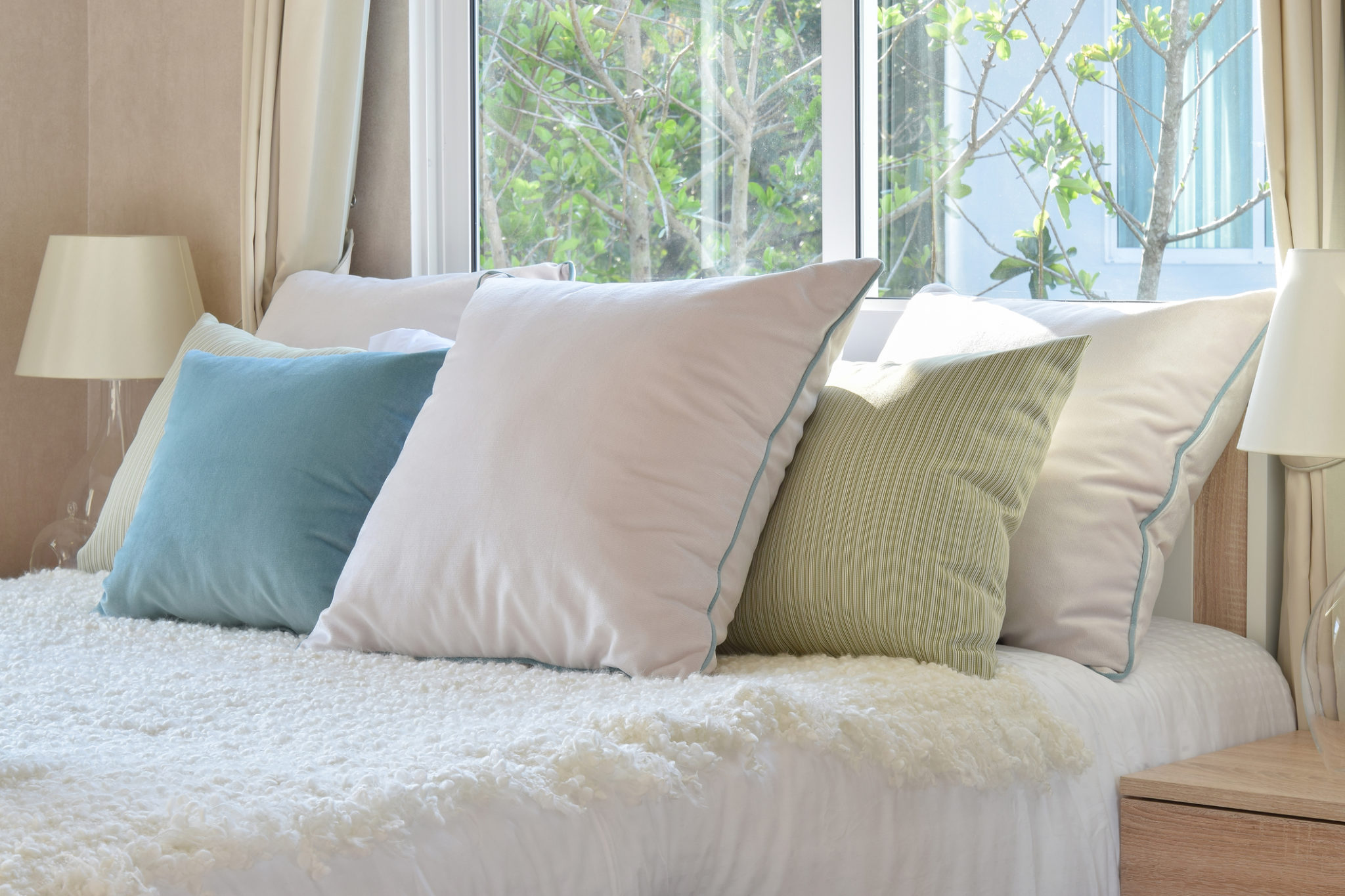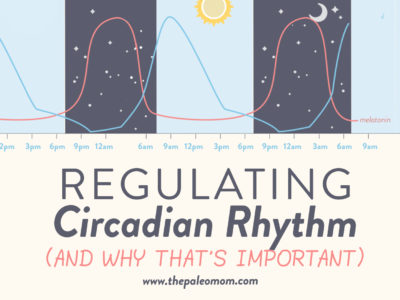Many of us have spent years being inundated with marketing about footwear that reduces foot strain, supports athletic performance, helps make walking and running safer, and generally just protects our feet from the harsh realities of the world. Chances are good that we’ve spent money at some point on shoes we believe will reduce pain or deliver other lower-body benefits.
In some cases, it’s intuitively obvious when a shoe isn’t great for us, even if we like how it looks (hello, stiletto heels!). But, what if the shoes that are supposed to improve our stride are actually causing harm, too? That’s the question driving the growing barefoot and minimalist shoe movement, which proposes that most commercial shoes cause us to adopt an unnatural gait and may actually be detrimental (and that walking barefoot, or as close to barefoot as possible, is not only safe, but beneficial).
From one perspective, it might make sense that walking barefoot—the way our ancestors did for generations on end—would be ideal for the human body. But, even though the Paleo community draws inspiration from evolutionary history, it’s important not to fall victim to the naturalistic fallacy (the idea that something must be good for us just because it’s natural, or conversely, bad for us because it’s not). What does science have to say about the shoe versus shoeless controversy, and what does that evidence mean for our footwear choices?
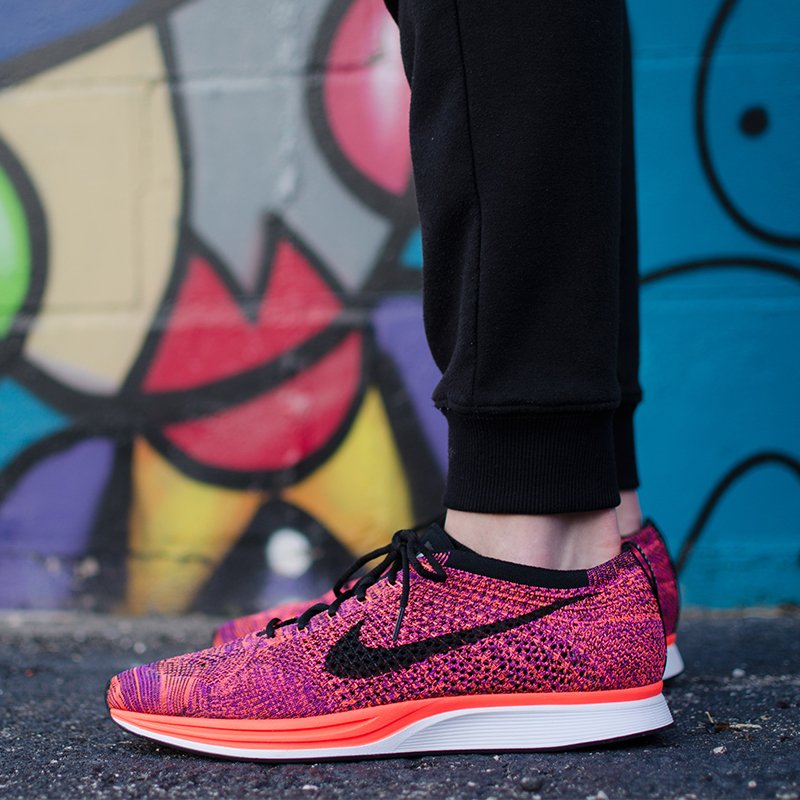
Save 80% Off the Foundations of Health
Expand your health knowledge on a wide range of topics relevant to you, from how to evaluate scientific studies, to therapeutic diet and lifestyle, to leaky gut and gut microbiome health, to sustainable weight loss, and much more!!!
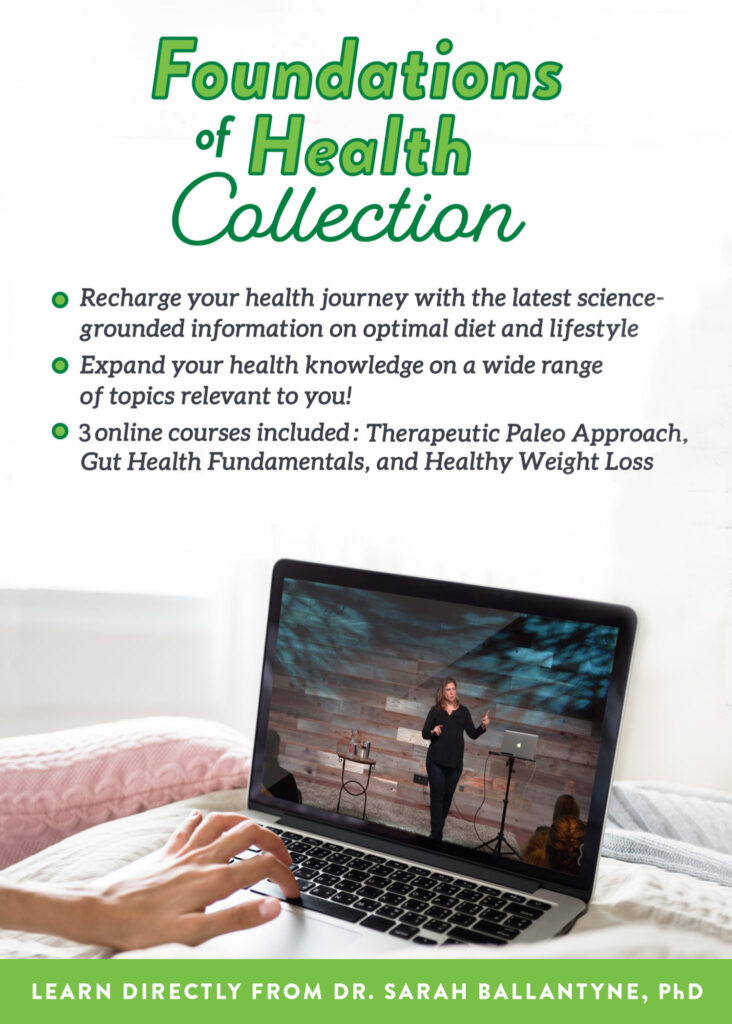
The Problem with Standard Running Shoes
Nearly every study on the subject of barefoot running, minimalist shoes, and standard running shoes shows that the more material on our feet, the more changes we experience in the biomechanics of our foot and leg motion. These changes include the angle of our ankles when our feet hit the ground, the frequency of our stride, the length of our steps, the number of rear-foot versus front-foot strikes (depending on the terrain), and other kinematic and kinetic variables related to our lower body adjusting to whatever material is hugging our feet. There’s little argument that footwear affects our stride in a big way!
But, are these changes harmful or helpful? Here’s where the controversy starts! Proponents of barefoot running and minimalist shoes claim that the loss of movement, flexing, and bending resulting from restrictive cushioned footwear ultimately weakens our feet, causes us to lose sensory feedback about our walking or running form, puts stress on our knees, and tightens some of the muscles in our lower body. So, while shoes may protect us from injury in the short-term, they might make us more susceptible to injury in the long run. (One analogy is what happens after we put a broken limb in a cast for two months. The limb is protected while in the cast, but during that time, it also becomes weaker and atrophied!) Some barefoot and minimalist shoe proponents also claim that ditching standard shoes can benefit foot problems such as plantar fasciitis, due to changes in the way the foot hits the ground.
Scientific Benefits of Barefoot Running
So, are these claims backed by science? In many cases, the answer is yes. Multiple studies have confirmed that barefoot running reduces the amount of stress placed on the knee, which may translate to fewer knee injuries over the course of time. One study shows that running barefoot causes immediate biomechanical and neuromuscular adaptations in the lower body (particularly the pelvis and hip) that persist even after the runners don shoes again, indicating that the body undertook some degree of “learning” while running barefoot. Compared to regular running shoes, going barefoot appears to reduce the risk of ankle sprains, possibly by increasing awareness of foot position or by altering the way the ankle twists after stumbling. One trial using minimalist shoes found that people who typically ran in regular shoes developed greater leg and foot muscle volume after transitioning to minimalist footwear (suggesting better utilization of muscles that aren’t fully engaged when wearing cushioned shoes). A systematic review and preliminary meta-analysis found that barefoot running appeared to trigger positive biomechanical changes (suggestive of injury prevention), especially among people who adopted a forefoot strike instead of landing on their heels. An analysis of close to 1000 runners also found significantly fewer reports of injury amongst those who were experienced in running barefoot or in minimalist shoes (people running with standard shoes were
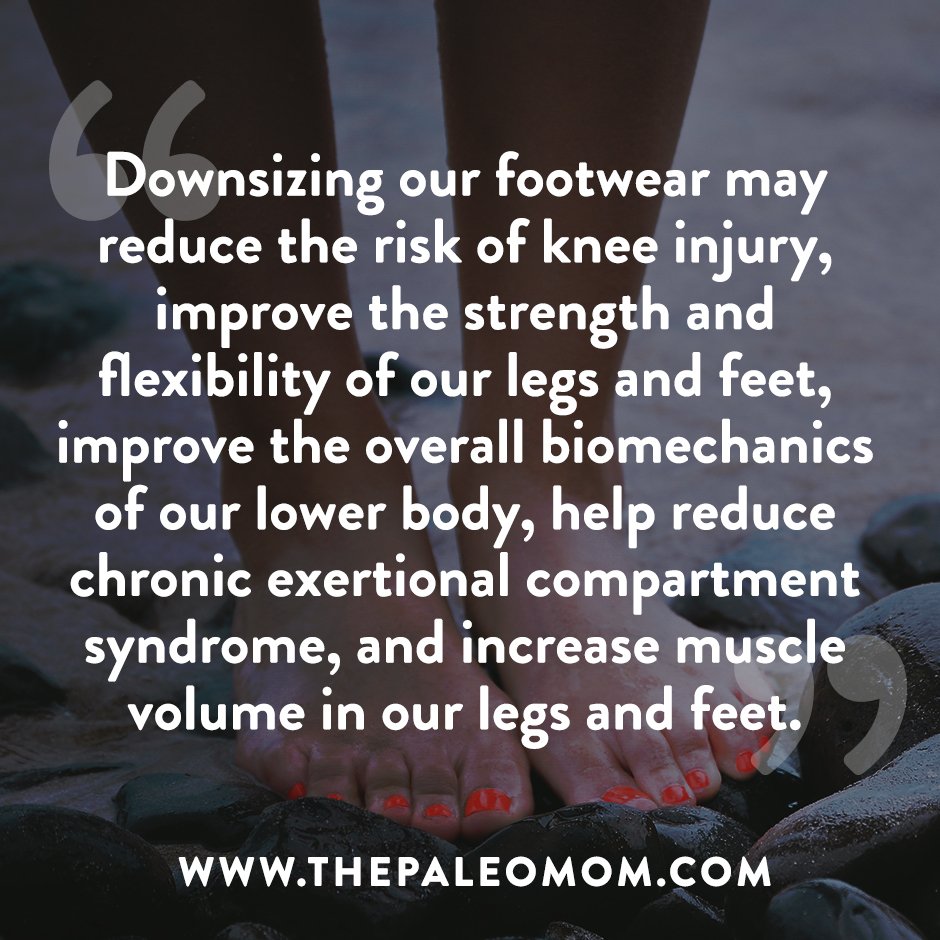
3.41 times more likely to report injuries!). And, additional research shows that switching to a forefoot-strike style of running (which generally occurs when running barefoot or in minimalist shoes) can benefit a condition called chronic exertional compartment syndrome (CECS), which is caused by athletic exertion and features pain, swelling, and sometimes disability.
So, what can we take away from the current research? Although we need more research to be able to thoroughly understand the mechanisms, there’s compelling evidence to suggest that downsizing our footwear may reduce the risk of knee injury (and possibly the injury of other joints and muscles), improve the strength and flexibility of our legs and feet, improve the overall biomechanics of our lower body, help reduce chronic exertional compartment syndrome, and increase muscle volume in our legs and feet. That’s not too shabby!
Injury Risk during the Transition Period
In recent years, though, a backlash against minimalist footwear and the barefoot movement has occurred due to case reports, clinical trials, and other evidence (including a lawsuit against a major minimalist shoe company, Vibram FiveFingers) suggesting that going shoeless either offers few benefits or can actually lead to more injuries. Should that deter us from switching footwear?
Given the relatively small number of barefoot and minimalist shoe trials that exist, the methodological weaknesses that plague them, and the difficulties inherent in conducting them, we should be careful how we interpret these reports. A huge problem with barefoot and minimalist shoe trials is that they capture the potentially dangerous adjustment period occurring when habitual shoe-wearers transition to a different type of footwear (or no footwear at all!). This transition period features a higher risk of injury due to the body relearning its stride, and can last much longer than most existing trials have documented—meaning we won’t get a clear sense of what the injury risk actually is once lifetime shoe wearers have fully adapted to being barefoot (or nearly so). (Going back to the limb-in-cast analogy, we wouldn’t expect an arm or a leg to function with optimal strength and flexibility once it’s fresh out of the cast—it takes time to rebuild strength and range of motion! The same goes for feet that have been coddled by shoes for many years of our lives. The adaptation process can potentially take many months.)
 Walk Before You Run
Walk Before You Run
We should also keep in mind that the dangers raised in clinical trials, case reports, and anecdotes emphasize the need to take it slowly while transitioning out of regular footwear. There’s no denying that the transition period can bring a higher risk of injury, especially if we don’t practice good form (hitting the ground incorrectly while wearing minimalist shoes or being barefoot is less forgiving than hitting the ground incorrectly while wearing nice, cushy soles!). In fact, studies that document the differences in participants’ foot-strike patterns have found that injury risk is generally limited to those who have a rear-strike pattern while running barefoot or in minimalist shoes (meaning the heel hits the ground first). This suggest that proper barefoot running form—a gliding motion that uses forefoot or midfoot strikes—might help prevent us from getting hurt. Ultimately, the transition period should take longer than we think we need and involve a conscious effort to adopt the correct stride. And anyone who wants to jog, run, or sprint should first practice walking before they attempt going any faster!
Which brings us to another question: what about those of us who just want to walk? Although most of the studies examining the effects of going barefoot or wearing minimalist shoes are done on long-distance runners, shedding our footwear can still offer benefits during other forms of activity. In fact, one study found that habitual barefoot walkers exhibited a number of beneficial biomechanical adaptations similar to what runners experience!
Barefoot versus Minimalist Shoes
We don’t fully understand how wearing minimalist shoes impacts our health relative to going totally barefoot. Even though both of these strategies cause important physical adaptations compared to wearing regular running shoes, the research we have comparing being barefoot with being minimally shoed suggests that there are still differences in their effects on the kinematics and kinetics of our lower body. On one hand, going totally barefoot seems to benefit how our knees and ankles are engaged while we move. But, minimalist shoes can help protect us from thermal injury, perforation, bruises, scrapes, and other smaller injuries that occur when our feet are fully exposed, while also conferring significant benefits compared to wearing regular shoes. I think a fair summary is: barefoot is best; wearing minimalist shoes is an awesome close second.
In my life, I strike the balance by being barefoot indoors (including while walking at my treadmill desk; see The Benefits of Gentle Movement) and wearing minimalist shoes when I’m out of the house.
Which minimalist shoes do I prefer? I’m so glad you asked!
 My Favorite: Xero Shoes
My Favorite: Xero Shoes
I first switched to minimalist shoes not-quite five years ago. I’ve since tried nearly a dozen different styles of minimalist footwear made by five different brands. When I first started wearing minimalist shoes, the bottoms of my feet would hurt after walking in them for an hour or two; when my feet started hurting, I switched back to regular shoes. Gradually, over the course of a couple of months, I wore my minimalist shoes more and more frequently. By about six months, I vastly preferred wearing minimalist shoes and seemed to have no time cap on how long they were comfortable (that’s when I started experimenting with different styles). I vividly remember shopping for a pair of ballet flats and applying the can-I-twist-this-shoe-into-a-ball test for the flexibility of the sole in the store to try to find a pair that wasn’t too rigid and restrictive in comparison to the minimalist shoes I owned at the time. Yep, I was a convert!
My criteria for minimalist shoes is as follows:
- They have to be super flexible and give me awesome biomechanical feedback—I want to feel the details of the ground and have full range of motion in my foot.
- My feet have to be protected—I like my minimalist shoes to be water-resistant (I don’t mind wet feet if I’m wading in a stream but I like to be able to walk in the rain and have my feet stay dry) and they need to completely protect my feet from sharp objects!
- They have to NOT look completely dorky! In fact, what I really want is for my shoes to just look like shoes!
M y favorite brand of minimalist footwear is Xero Shoes. They tick all the boxes and then some! They are the most innovative minimalist shoe I’ve ever seen with completely unique features. Xero Shoes have crazy flexible soles (you can literally roll the shoes up into a ball) that let you feel the ground, recruit more of the muscles and nerves in your feet and follow a more natural movement pattern. Their zero heel drop means better alignment and posture so they benefit your whole body, not just in your feet. The enclosed shoes like the Xero Prio sneakers feature a wide toe box that lets your feet relax. And, the special soles are designed to provide enough protection to keep you safe, and they last for 5,000 miles!
y favorite brand of minimalist footwear is Xero Shoes. They tick all the boxes and then some! They are the most innovative minimalist shoe I’ve ever seen with completely unique features. Xero Shoes have crazy flexible soles (you can literally roll the shoes up into a ball) that let you feel the ground, recruit more of the muscles and nerves in your feet and follow a more natural movement pattern. Their zero heel drop means better alignment and posture so they benefit your whole body, not just in your feet. The enclosed shoes like the Xero Prio sneakers feature a wide toe box that lets your feet relax. And, the special soles are designed to provide enough protection to keep you safe, and they last for 5,000 miles!
Xero Shoes offer awesome fashionable sandal and casual styles for men and women! Plus, they’re always innovating so you can count on new styles and colors in the future! I can’t recommend Xero Shoes highly enough!
Citations
Azevedo AP, et al. “16 Weeks of Progressive Barefoot Running Training Changes Impact Force and Muscle Activation in Habitual Shod Runners.” PLoS One. 2016 Dec 1;11(12):e0167234. doi: 10.1371/journal.pone.0167234. eCollection 2016.
Bonacci J, et al. “Running in a minimalist and lightweight shoe is not the same as running barefoot: a biomechanical study.” Br J Sports Med. 2013 Apr;47(6):387-92. doi: 10.1136/bjsports-2012-091837. Epub 2013 Jan 11.
Bonacci J, et al. “Take your shoes off to reduce patellofemoral joint stress during running.” Br J Sports Med. 2014 Mar;48(6):425-8. doi: 10.1136/bjsports-2013-092160. Epub 2013 Jul 13.
Cauthon DJ, et al. “Minimalist shoe injuries: three case reports.” Foot (Edinb). 2013 Jun-Sep;23(2-3):100-3. doi: 10.1016/j.foot.2013.03.001. Epub 2013 May 10.
Chen TL, et al. “Effects of training in minimalist shoes on the intrinsic and extrinsic foot muscle volume.” Clin Biomech (Bristol, Avon). 2016 Jul;36:8-13. doi: 10.1016/j.clinbiomech.2016.05.010. Epub 2016 May 10.
D’Aout K, et al. “The effects of habitual footwear use: foot shape and function in native barefoot walkers.” Footwear Science. 2009;1(2):81-94.
Diebal AR, et al. “Forefoot running improves pain and disability associated with chronic exertional compartment syndrome.” Am J Sports Med. 2012 May;40(5):1060-7. doi: 10.1177/0363546512439182. Epub 2012 Mar 16.
Franklin S, et al. “Barefoot vs common footwear: A systematic review of the kinematic, kinetic and muscle activity differences during walking.” Gait Posture. 2015 Sep;42(3):230-9. doi: 10.1016/j.gaitpost.2015.05.019. Epub 2015 Jun 3.
Goss DL & Gross MT. “Relationships among self-reported shoe type, footstrike pattern, and injury incidence.” US Army Med Dep J. 2012 Oct-Dec:25-30.
Gruber AH, et al. “Economy and rate of carbohydrate oxidation during running with rearfoot and forefoot strike patterns.” J Appl Physiol (1985). 2013 Jul 15;115(2):194-201. doi: 10.1152/japplphysiol.01437.2012. Epub 2013 May 16.
Hall JP, et al. “The biomechanical differences between barefoot and shod distance running: a systematic review and preliminary meta-analysis.” Sports Med. 2013 Dec;43(12):1335-53. doi: 10.1007/s40279-013-0084-3.
Hashish R, et al. “Lower limb dynamics vary in shod runners who acutely transition to barefoot running.” J Biomech. 2016 Jan 25;49(2):284-8. doi: 10.1016/j.jbiomech.2015.12.002. Epub 2015 Dec 11.
Hollander K, “Comparison of Minimalist Footwear Strategies for Simulating Barefoot Running: A Randomized Crossover Study.” PLoS ONE. 2015;10(5):e0125880. https://doi.org/10.1371/journal.pone.0125880
Kulmala JP, et al. “Forefoot strikers exhibit lower running-induced knee loading than rearfoot strikers.” Med Sci Sports Exerc. 2013 Dec;45(12):2306-13. doi: 10.1249/MSS.0b013e31829efcf7.
Lucas-Cuevas AG, et al. “Initiating running barefoot: Effects on muscle activation and impact accelerations in habitually rearfoot shod runners.” Eur J Sport Sci. 2016 Nov;16(8):1145-52. doi: 10.1080/17461391.2016.1197317. Epub 2016 Jun 26.
Shu Y, et al. “Foot Morphological Difference between Habitually Shod and Unshod Runners.” Baur H, ed. PLoS ONE. 2015;10(7):e0131385. doi:10.1371/journal.pone.0131385.
Strauts J, et al. “Acute changes in kinematic and muscle activity patterns in habitually shod rearfoot strikers while running barefoot.” J Sports Sci. 2016;34(1):75-87. doi: 10.1080/02640414.2015.1034756. Epub 2015 Apr 24.
Tam N, et al. “Individual Responses to a Barefoot Running Program: Insight Into Risk of Injury.” Am J Sports Med. 2016 Mar;44(3):777-84. doi: 10.1177/0363546515620584. Epub 2016 Jan 7.

